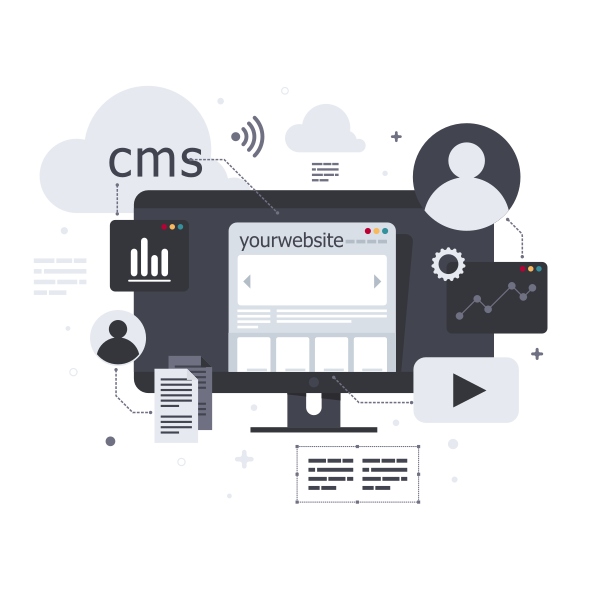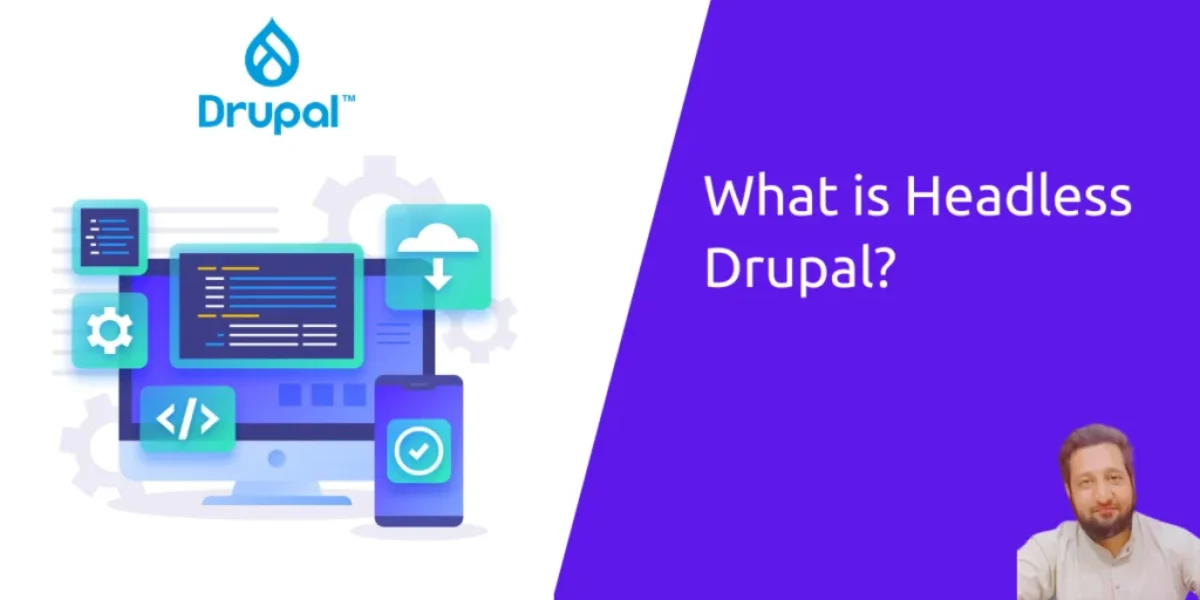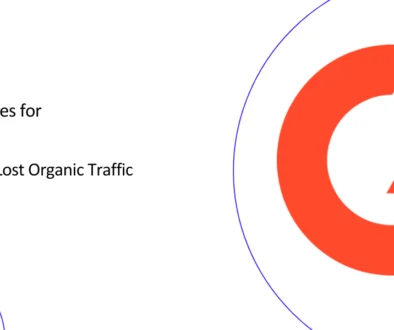What is Headless Drupal/Decoupled Drupal? A Complete Guide
What is a Headless CMS?
In simplest possible words, Headless CMS separates content from where it shows up. By separating the presentation layer (where content is presented) from the backend (where content is managed). A headless CMS allows you to manage content in one place and be able to deploy that content on any digital channel you choose (website, mobile app, smart watch or even digital signage). Separating the frontend from the backend unlocks your content, making it easier for marketers to manage content independently, and for developers to build faster, automate changes, and manage digital at scale.
Headless CMS is a system that lets you manage all your content in one place and use it anywhere you want. You can create amazing things with any tools you like, from websites and mobile apps to smartwatches and even digital signage screens. Your content is free to fly across any platform, device, or channel. Headless CMS is like Lego: You can make different things with the same content pieces on any digital surface.
What Is Headless Drupal/Decoupled Drupal?
Headless Drupal or decoupled Drupal is a way of using Drupal as a headless content management system without relying on its default presentation layer. This means that you can create and store your content in Drupal, but use different technologies to display it on various platforms and devices.
This gives you more control and flexibility over how your content looks and feels, as well as how it interacts with your users. You can use any front-end framework or tool that suits your needs, such as React, Angular, Vue, or even native mobile apps. You can also deliver your content to multiple channels at once, such as websites, apps, kiosks, or smart TVs. With headless Drupal, you can unleash your creativity and build amazing digital experiences.
3 Types of Drupal Architecture
Drupal is a free and open-source content management system (CMS) that’s behind some of the most well-known websites and digital experiences in the world. From government websites and educational platforms to e-commerce stores and personal blogs, Drupal is built to handle even the most demanding websites and applications as it’s known for its stability, performance, and robust security features, making it a trusted choice for businesses and organizations of all sizes. Unlike some traditional CMSs, Drupal is not a one-size-fits-all solution. It’s designed to be flexible, composable and adaptable to your specific needs. There are 3 different deployment options for Drupal CMS, depending on your project requirements.
Unified (Traditional)
In this type of deployment/framework, Drupal handles both the front-end rendering and back-end content management. This means that Drupal provides the back-end content management system and an HTML rendering engine called ‘Twig’ in a composable framework.
Decoupled/headless
In the decoupled deployment, Drupal’s back end acts as a content repository that stores and manages data, making it available via APIs to the front-end systems for rendering. The headless Drupal repository and the decoupled application exchange data through standard HTTP methods, with the application making a request and receiving a JSON response.

Hybrid/Progressive Decoupling
In this approach, the benefits of a headless approach are combined with the advantages of a Unified approach. Progressive Decoupling lets you use Drupal to create the initial page and then use JavaScript to change it as needed. You can use different languages for different parts of your website and still enjoy Drupal’s powerful backend features.
This method gives you the best of both worlds: you can keep the benefits of Drupal for editing and managing your content, and you can also use JavaScript for creating dynamic and engaging user interfaces. Progressive Decoupling allows parts of the site to be decoupled without committing to either a unified or fully decoupled architecture.
The difference between Standard and Headless Drupal
| Feature | Standard Drupal | Decoupled Drupal |
| Architecture | Monolithic | Separate backend and frontend |
| Frontend | Twig-based themes | Any frontend technology |
| Communication | Direct server-side rendering | API-based data exchange (JSON, REST, GraphQL) |
| Content Delivery | HTML pages | Structured data (JSON, etc.) |
| Use Cases | Traditional websites, blogs, content portals | Complex web applications, multi-channel content delivery, frontend-heavy experiences |
Advantages of Headless Drupal
Benefits of Headless Drupal for content creators
Since Headless Drupal separates the back-end from the front-end, content creators can use Drupal’s interface to create and organize content that can be shared across different platforms and devices. They can also create content in a modular way, which means they can reuse the same content in different places without worrying about how the content will look on different devices.
Headless Drupal embraces a modular approach, enabling you to construct content like reusable building blocks. Craft a captivating case study once, and effortlessly weave it into blog posts, product demos, or even interactive SaaS onboarding experiences. This flexibility empowers you to focus on what matters most: creating content that captivates and converts. And when it comes to personalization, headless Drupal excels. Deliver tailored content journeys across every channel, ensuring customers feel understood and valued every step of the way.
Benefits for developers

Developers love headless Drupal for its incredible flexibility. Instead of being stuck with one technology for both content management and website layout, they get complete freedom to choose the best tools for each job. Imagine crafting web interfaces with sizzling-fast JavaScript frameworks for ultimate responsiveness, building sleek mobile apps for on-the-go users, or even connecting to cutting-edge devices like smart TVs – all seamlessly fed by Drupal’s content powerhouse. This creative freedom results in modern, engaging experiences that adapt to any platform, delight your users, and push the boundaries of what’s possible.
Headless Drupal empowers developers to be true digital artists, painting experiences with the perfect brushstrokes of diverse technologies. They can sculpt interactive elements, weave in playful animations, and fine-tune every detail to bring your vision to life.
Benefits for end-users
Headless Drupal allows for crafting user experiences as unique as the devices and situations they’re meant for. Mobile apps with lightning-fast loading on sluggish connections? Or web experiences tailored to wearables? Go for it! Headless Drupal fuels dynamic content delivery, keeping users engaged regardless of their digital playground. Plus, integration with external tools empowers developers to build powerful features that make interacting with your content a joyride. This laser focus on user experience translates to happier and more engaged users.
Disadvantages of Headless Drupal
While headless Drupal boasts powerful advantages, consider its potential drawbacks before diving in. One significant hurdle is the increased technical expertise required. Building and maintaining these decoupled sites demands developers well-versed in both back-end and front-end technologies, typically pushing development costs higher due to the need for specialized skillsets. Furthermore, the intricate architecture and integrations within headless Drupal can lengthen implementation times compared to traditional setups, increasing resource demands.
For smaller teams or organizations lacking dedicated technical prowess, managing and maintaining headless Drupal can prove challenging. Keeping the website updated and troubleshooting issues becomes an uphill battle without access to a skilled team or reliable partner. Weighing the resource needs and technical expertise against your project’s requirements is crucial before embracing the world of headless Drupal.
What are the most important factors to consider when choosing a front-end technology for a headless Drupal project?
Picking the perfect front-end tech for headless Drupal is crucial for your project. While you can go with any option, each comes with its own mix of perks and pain points. The ideal choice hinges on several factors like your team’s skillset, tech preferences, and user needs.
Popular frameworks like React excel in performance and reusability, while Angular boasts a comprehensive toolbox. If you prefer something lighter and more adaptable, consider Vue.js. Remember, the key is to weigh your options carefully and choose the tech that best aligns with your project’s goals, budget, and timeline. Partnering with a skilled developer can also guide you through this complex decision and ensure you pick the winner for your unique needs.
Decoupled Drupal: Why React & Next.js Reign Supreme?
React for a Blazing Fast Frontend
Drupal’s strength lies in its powerful content management capabilities, but its traditional frontend can feel heavy and slow. Here’s how React steps in like a superhero:
- Speed: React builds lightning-fast UIs by focusing on reusable components and virtual DOM manipulation. Your website or app feels snappy and responsive, keeping users engaged and happy.
- Components: Think of building blocks. React lets you break down your website into independent, reusable components. This makes development and maintenance a breeze, especially for complex designs. Plus, sharing components across projects becomes a piece of cake!
Next.js: Taking React to the Next Level
Next.js builds upon React’s power and adds some serious superpowers of its own:
- SEO: Websites need to be seen. Next.js out-of-the-box features like automatic static site generation (SSG) and server-side rendering (SSR) ensure your content gets top billing in search engine results.
- Routing: Building dynamic interfaces with multiple pages can be tricky. Next.js handles routing like a dream, taking users seamlessly between pages without ever feeling lost. It’s like having a built-in GPS for your website!
What makes Headless Drupal and JAMstack such a winning team for building modern websites?
Traditional websites are like one-piece swimsuits – everything is connected and changing one thing means affecting everything else. Headless Drupal and JAMstack are like a mix-and-match outfit – the content (Drupal) and presentation (JAMstack) are separate, giving you ultimate flexibility.
JAMstack, which stands for JavaScript, APIs, and Markup, is a modern web architecture that emphasizes speed, security, and scalability. By decoupling the content and presentation, developers can use APIs to deliver content to any device or platform, like a phone app or a smartwatch. This makes websites super fast and adaptable.
On top of that, JAMstack is secure because there’s no direct connection between the content and presentation, making it harder for hackers to attack. Plus, JAMstack sites are hosted on a content delivery network (CDN), which is like having many website copies around the world, so even if there’s a traffic surge, your website won’t slow down.
Decoupled Drupal: Not for Everyone
While decoupling Drupal offers a smooth, app-like experience, it’s not a one-size-fits-all solution. Here’s why:
1. Static Sites Don’t Need It: For news sites or blogs with minimal interactivity, decoupling is overkill. Drupal’s built-in themes handle layout, previews, and security efficiently, making decoupling’s complexity unnecessary.
2. Feature Trade-off: Decoupling means sacrificing some free Drupal features like block placements and UI localization. While client-side frameworks can fill some gaps, not all features can be fully replicated, requiring custom development.
3. Cost Considerations: Decoupling requires experienced front-end developers, which can be expensive. Additionally, missing Drupal features might need to be rebuilt from scratch, further adding to the cost.
Headless
Headle
Headless CMS: The Only Solution to Developing High-Performing Single Page Applications (SPAs)
While Headless CMSs require more upfront development, they offer unparalleled freedom for crafting exceptional Single Page Applications (SPAs). Unlike traditional CMSs that tightly couple content and presentation, Headless systems liberate content as raw data, typically JSON, through APIs. This seamless integration empowers SPAs to dynamically fetch and consume content, unlocking a host of advantages for modern web experiences.
Traditional CMSs, in contrast, primarily generate prepackaged HTML pages on the server, which can hinder SPAs seeking frequent content updates without full page reloads. This constraint often results in sluggish interactions and less responsive interfaces. Headless CMSs, on the other hand, empower developers to craft fully customized UIs, optimized for performance and tailored to specific user needs. This translates to lightning-fast loading speeds, buttery-smooth interactions, and seamless adaptability across diverse devices and screen sizes — critical elements for delivering exceptional user experiences in today’s digital landscape.
What are some examples of major websites using headless Drupal and which front-end frameworks do they rely on?
Big companies love their fast, interactive websites built with headless Drupal! These sites use different front-end tools like:
- The Tonight Show with Jimmy Fallon: Backbone.js, Node.js
- Weather.com: Angular.js
- Great Wolf Resorts: CoffeeScript, Spine framework
- EC Red Bull Salzburg: Angular.js
Headless Drupal: Busting Common Myths
Headless Drupal has been generating buzz, but navigating the hype can be tricky. Let’s demystify some prevalent concerns about SEO, customizability, security, and workload to understand if it’s the right fit for your website.
Myth #1: Headless Drupal hurts SEO.
False! Decoupling simply separates content from presentation, not from the crawling eyes of search engines. Your content remains accessible and indexable, just like in a traditional Drupal setup.
Myth #2: Headless Drupal ditches core features.
Not entirely true. Building your front-end from scratch opens up possibilities, but core components like blocks, Layout Builder, and menus can still be used. Retrofiting an existing site is also feasible, and Paragraphs work seamlessly in decoupled builds.
Myth #3: Headless Drupal exposes security vulnerabilities.
Misconception! Authentication stays securely within Drupal, while the public-facing front-end operates on a separate domain. This actually enhances security by not exposing sensitive paths like “/user”.
Myth #4: Headless Drupal is a developer nightmare.
Surprise! Development can be faster and more enjoyable. Many tasks handled by Drupal in a traditional setup shift to the front-end, streamlining the CMS build. Additionally, frameworks like React.js and Next.js offer a vast library of reusable code, simplifying integration and boosting developer productivity.
How can Manmash Consulting help?
Me and my team are not just Drupal developers; we’re headless Drupal enthusiasts. We’ll guide you through every step, from strategizing your ideal headless setup to integrating it seamlessly with your existing systems.
Think of Manmash Consulting as your trusted partners in headless CMS implementation. My Drupal consultants will help you break free from the limitations of traditional CMS and discover a world of possibilities where content and user experience truly reigns supreme. Contact me on my Linkedin profile and together, let’s build the digital experiences that captivate your audience and propel your business forward. You can also contact me on my Whatsapp +923331200550.




